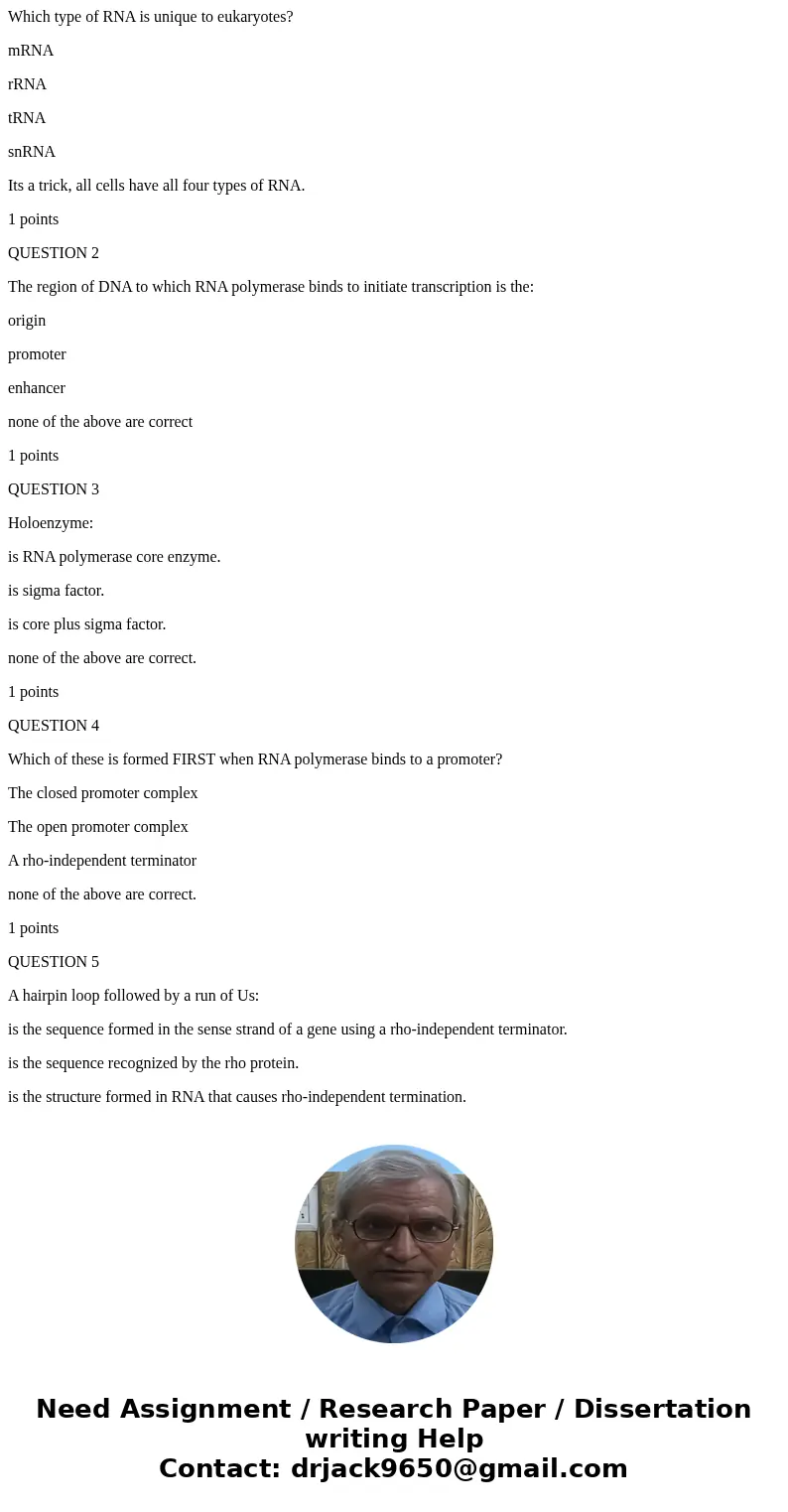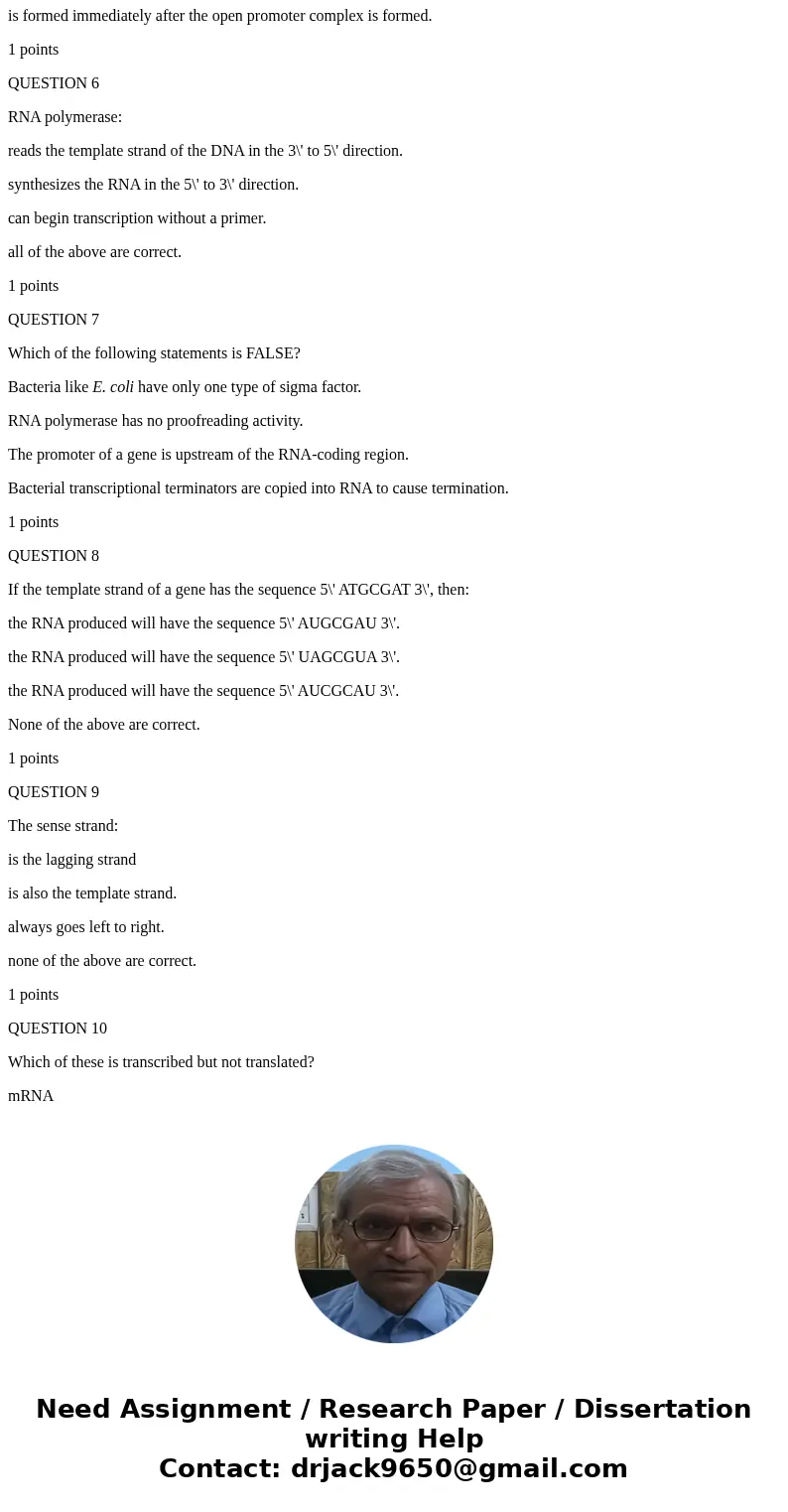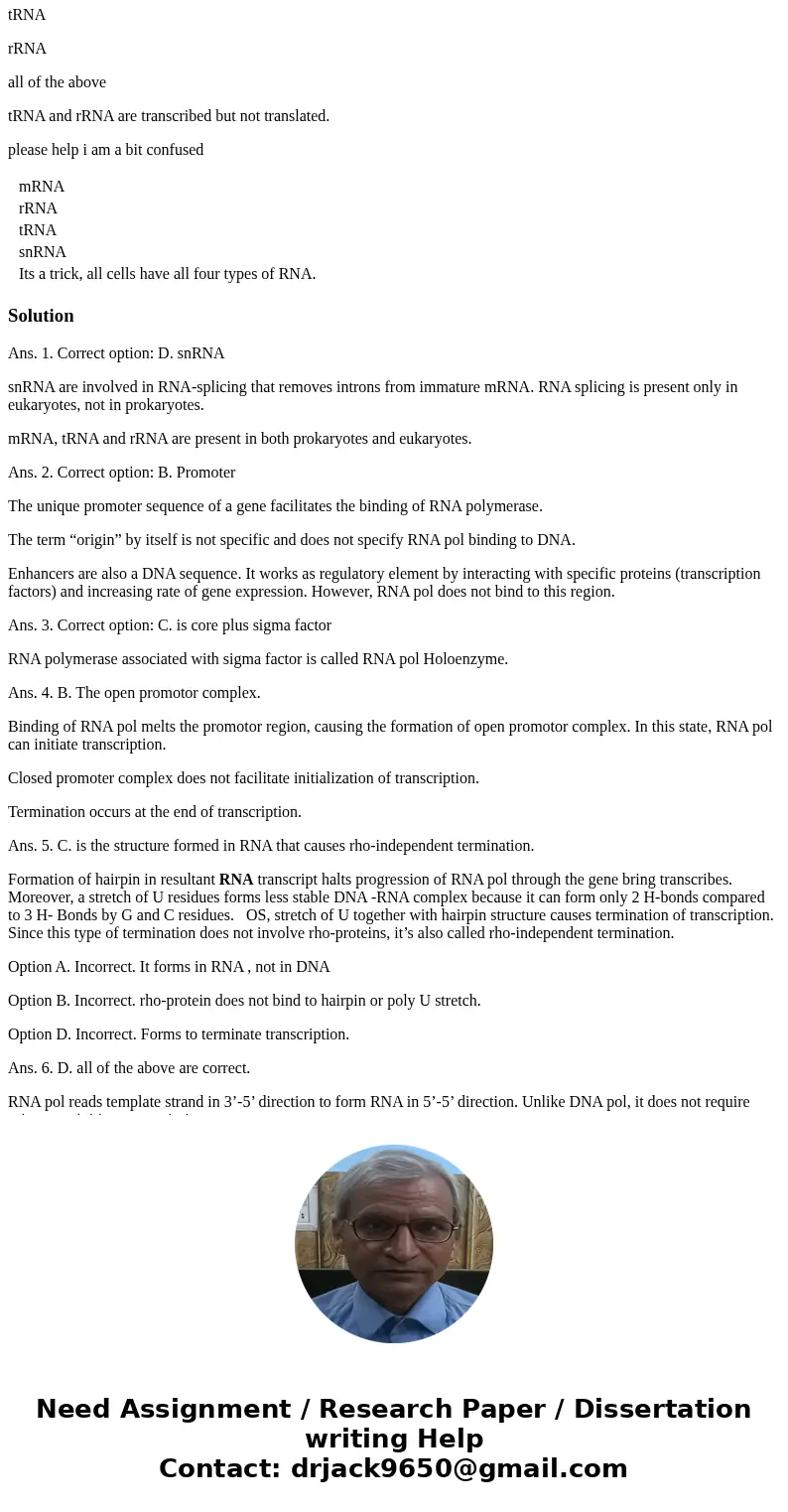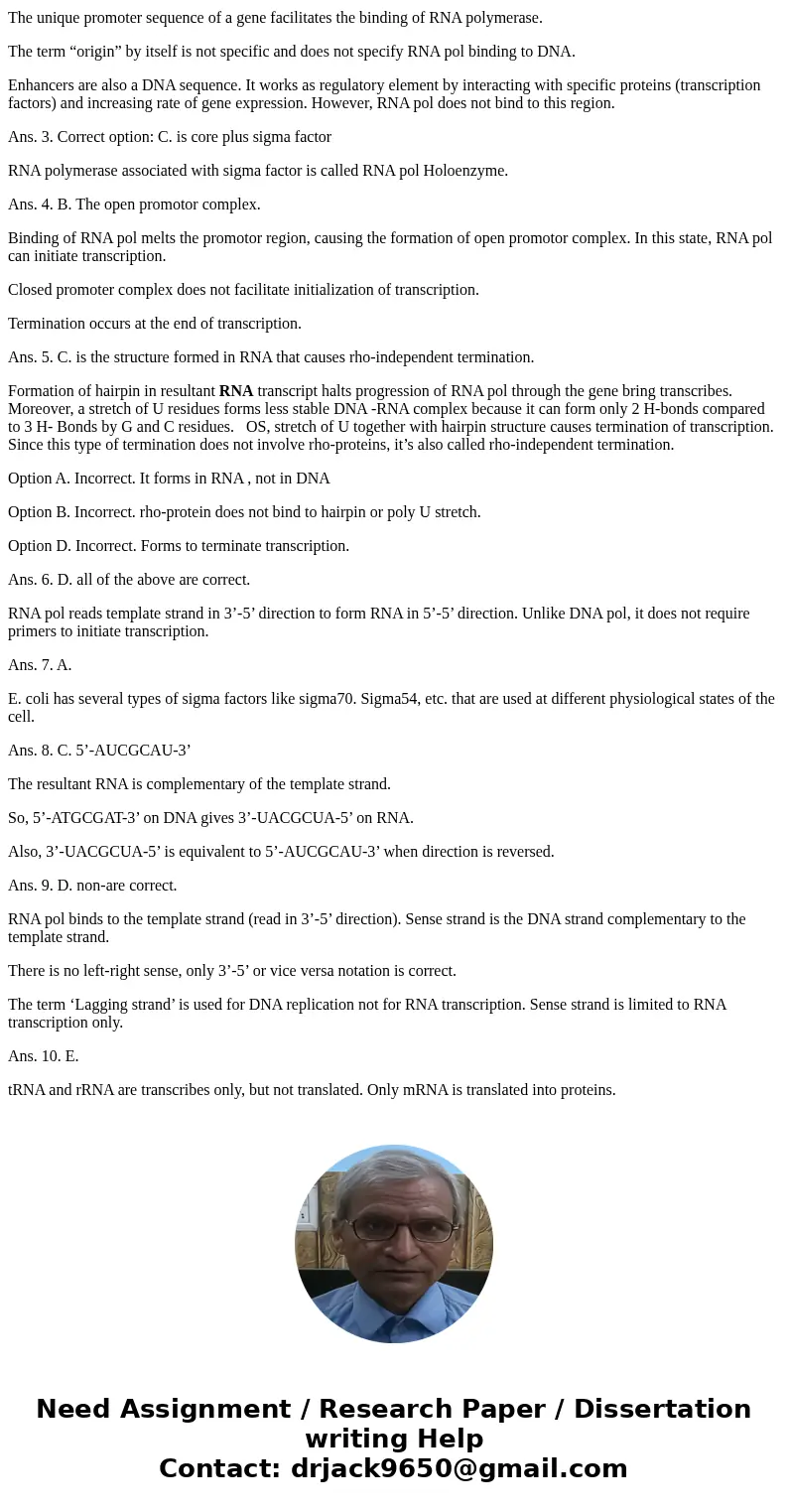Which type of RNA is unique to eukaryotes mRNA rRNA tRNA snR
Which type of RNA is unique to eukaryotes?
mRNA
rRNA
tRNA
snRNA
Its a trick, all cells have all four types of RNA.
1 points
QUESTION 2
The region of DNA to which RNA polymerase binds to initiate transcription is the:
origin
promoter
enhancer
none of the above are correct
1 points
QUESTION 3
Holoenzyme:
is RNA polymerase core enzyme.
is sigma factor.
is core plus sigma factor.
none of the above are correct.
1 points
QUESTION 4
Which of these is formed FIRST when RNA polymerase binds to a promoter?
The closed promoter complex
The open promoter complex
A rho-independent terminator
none of the above are correct.
1 points
QUESTION 5
A hairpin loop followed by a run of Us:
is the sequence formed in the sense strand of a gene using a rho-independent terminator.
is the sequence recognized by the rho protein.
is the structure formed in RNA that causes rho-independent termination.
is formed immediately after the open promoter complex is formed.
1 points
QUESTION 6
RNA polymerase:
reads the template strand of the DNA in the 3\' to 5\' direction.
synthesizes the RNA in the 5\' to 3\' direction.
can begin transcription without a primer.
all of the above are correct.
1 points
QUESTION 7
Which of the following statements is FALSE?
Bacteria like E. coli have only one type of sigma factor.
RNA polymerase has no proofreading activity.
The promoter of a gene is upstream of the RNA-coding region.
Bacterial transcriptional terminators are copied into RNA to cause termination.
1 points
QUESTION 8
If the template strand of a gene has the sequence 5\' ATGCGAT 3\', then:
the RNA produced will have the sequence 5\' AUGCGAU 3\'.
the RNA produced will have the sequence 5\' UAGCGUA 3\'.
the RNA produced will have the sequence 5\' AUCGCAU 3\'.
None of the above are correct.
1 points
QUESTION 9
The sense strand:
is the lagging strand
is also the template strand.
always goes left to right.
none of the above are correct.
1 points
QUESTION 10
Which of these is transcribed but not translated?
mRNA
tRNA
rRNA
all of the above
tRNA and rRNA are transcribed but not translated.
please help i am a bit confused
| mRNA | ||
| rRNA | ||
| tRNA | ||
| snRNA | ||
| Its a trick, all cells have all four types of RNA. |
Solution
Ans. 1. Correct option: D. snRNA
snRNA are involved in RNA-splicing that removes introns from immature mRNA. RNA splicing is present only in eukaryotes, not in prokaryotes.
mRNA, tRNA and rRNA are present in both prokaryotes and eukaryotes.
Ans. 2. Correct option: B. Promoter
The unique promoter sequence of a gene facilitates the binding of RNA polymerase.
The term “origin” by itself is not specific and does not specify RNA pol binding to DNA.
Enhancers are also a DNA sequence. It works as regulatory element by interacting with specific proteins (transcription factors) and increasing rate of gene expression. However, RNA pol does not bind to this region.
Ans. 3. Correct option: C. is core plus sigma factor
RNA polymerase associated with sigma factor is called RNA pol Holoenzyme.
Ans. 4. B. The open promotor complex.
Binding of RNA pol melts the promotor region, causing the formation of open promotor complex. In this state, RNA pol can initiate transcription.
Closed promoter complex does not facilitate initialization of transcription.
Termination occurs at the end of transcription.
Ans. 5. C. is the structure formed in RNA that causes rho-independent termination.
Formation of hairpin in resultant RNA transcript halts progression of RNA pol through the gene bring transcribes. Moreover, a stretch of U residues forms less stable DNA -RNA complex because it can form only 2 H-bonds compared to 3 H- Bonds by G and C residues. OS, stretch of U together with hairpin structure causes termination of transcription. Since this type of termination does not involve rho-proteins, it’s also called rho-independent termination.
Option A. Incorrect. It forms in RNA , not in DNA
Option B. Incorrect. rho-protein does not bind to hairpin or poly U stretch.
Option D. Incorrect. Forms to terminate transcription.
Ans. 6. D. all of the above are correct.
RNA pol reads template strand in 3’-5’ direction to form RNA in 5’-5’ direction. Unlike DNA pol, it does not require primers to initiate transcription.
Ans. 7. A.
E. coli has several types of sigma factors like sigma70. Sigma54, etc. that are used at different physiological states of the cell.
Ans. 8. C. 5’-AUCGCAU-3’
The resultant RNA is complementary of the template strand.
So, 5’-ATGCGAT-3’ on DNA gives 3’-UACGCUA-5’ on RNA.
Also, 3’-UACGCUA-5’ is equivalent to 5’-AUCGCAU-3’ when direction is reversed.
Ans. 9. D. non-are correct.
RNA pol binds to the template strand (read in 3’-5’ direction). Sense strand is the DNA strand complementary to the template strand.
There is no left-right sense, only 3’-5’ or vice versa notation is correct.
The term ‘Lagging strand’ is used for DNA replication not for RNA transcription. Sense strand is limited to RNA transcription only.
Ans. 10. E.
tRNA and rRNA are transcribes only, but not translated. Only mRNA is translated into proteins.




 Homework Sourse
Homework Sourse